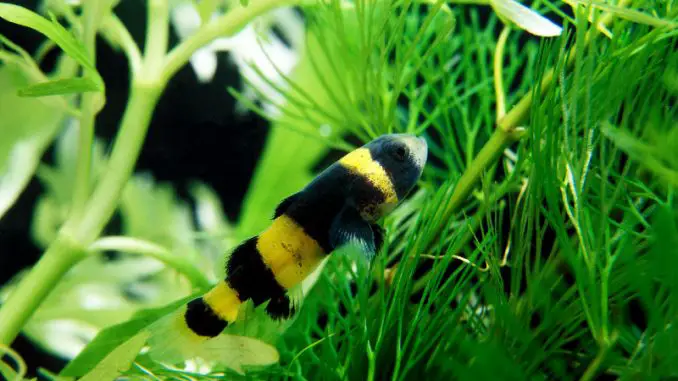
Home aquariums are usually freshwater or saltwater, but there is a whole world in between. Brackish setups are underappreciated, there is a lot they can offer.
One example is the Bumblebee Goby, an attractive fish and social fish that livens up the lower regions of fish tanks.
They are a little more challenging than most species to care for, so beginners might want to get some experience elsewhere first.
Aquarists with some know-how will enjoy the challenge. Bumblebee Gobies are a great introduction to brackish aquariums.
If you are thinking about purchasing some Bumblebee Gobies, then read on. We will talk about everything you need to know, including their preferred brackish habitat and their tricky feeding needs.
Bumblebee Goby Facts & Overview
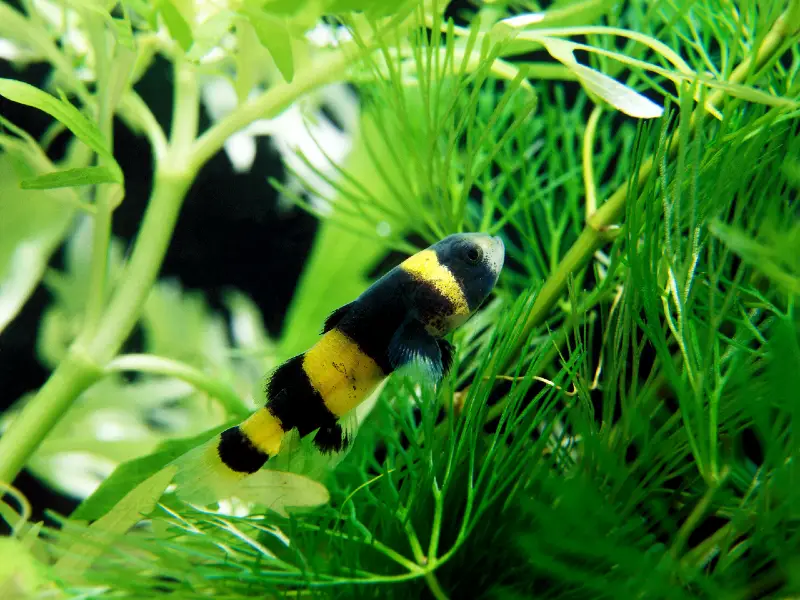
| Category | Rating |
| Care Level: | Intermediate |
| Temperament: | Peaceful |
| Color Form: | Black and yellow stripes |
| Lifespan: | Up to 3 years |
| Size: | Up to 1.5 inches |
| Diet: | Carnivore; live/frozen foods |
| Family: | Oxudercinae |
| Minimum Tank Size: | 10 gallons |
| Tank Set-Up: | Brackish water with sand and hiding spots |
| Compatibility: | Small peaceful fish or a single-species setup |
The Bumblebee Goby is a species that lives in brackish water. This means their preferred salinity falls between freshwater and saltwater.
This puts some people off. Some aquarists aren’t comfortable with handling salinity, others don’t like the limited number of tank mates available for brackish water aquariums.
If you are prepared for a brackish setup then these fish are an excellent choice.
They are known scientifically as Brachygobius, a genus in the Oxudercidae family. This family contains all mudskippers and gobies, which can be found all over the world.
Bumblebee Gobies are native to Asia, specifically Thailand and Indonesia. Here they live in the shallow areas of estuaries and mangroves, where rivers meet the sea.
There are a few species sold under the name Brachygobius, but they are incredibly similar, so it is difficult to notice the differences between them. Don’t worry about this when purchasing some.
Each fish should cost you under $5.
Make sure you are purchasing some healthy individuals; check for signs of disease or injury. Go to a different store if there are any problems.
When kept in a healthy environment, a Bumblebee Goby should live for about 3 years. They could live even longer, but this depends on the individual fish and the quality of care.
Typical Behavior
These are bottom-dwelling fish that spend most of their time roaming across the substrate where they can pick up any food they come across.
Once first introduced, they may be a bit shy. They’ll gradually become more confident as they get used to their surroundings and claim a territory.
They’re generally a peaceful species, though males will sometimes show signs of aggression towards each other.
This is usually a territorial dispute, but they’ll just chase each other away and rarely cause injuries. Their preferred response is to hide rather than fight.
Providing lots of hiding spaces will help to reduce this.
Bumblebee Gobies are actually quite social the rest of the time. They enjoy being around others of their own kind and will interact together. Don’t keep them on their own.
Sometimes you will see them swimming around in a group, but they like spending some time individually as well.
Appearance
These are attractive fish, which pairs wonderfully with their interesting personalities to make a tempting tank mate for home aquariums.
Their common name does a good job of describing what they look like. They have thick black and yellow vertical stripes from their head to the base of their tail, resembling a bumblebee.
Sometimes these stripes extend to the fins, but the fins are usually clear.
This species has a round head and plump body, increasing its similarity to a bumblebee. They even jump around between surfaces like a bee too.
These gobies share the same classic body shape as most goby species. This includes ventral fins that form suction cups that allow the fish to attach themselves to surfaces in the tank.
Their dorsal fins are relatively short, and the caudal fin is small, rounded, and fan-like.
A fully grown fish rarely reaches longer than 1.5 inches, making them small fish that don’t need much space.
Sexing Bumblebee Gobies can be tough. Females tend to be a little fatter with a rounder abdomen, especially when holding eggs during spawning. Males become more colorful when spawning too.
There are many closely related species in the Brachygobius genus, but the differences between them are so slight that it can be difficult to tell them apart. They share similar requirements though.
The species is usually identified by counting scales, but this requires a microscope, so you won’t be able to do this at home.
Habitat and Tank Conditions
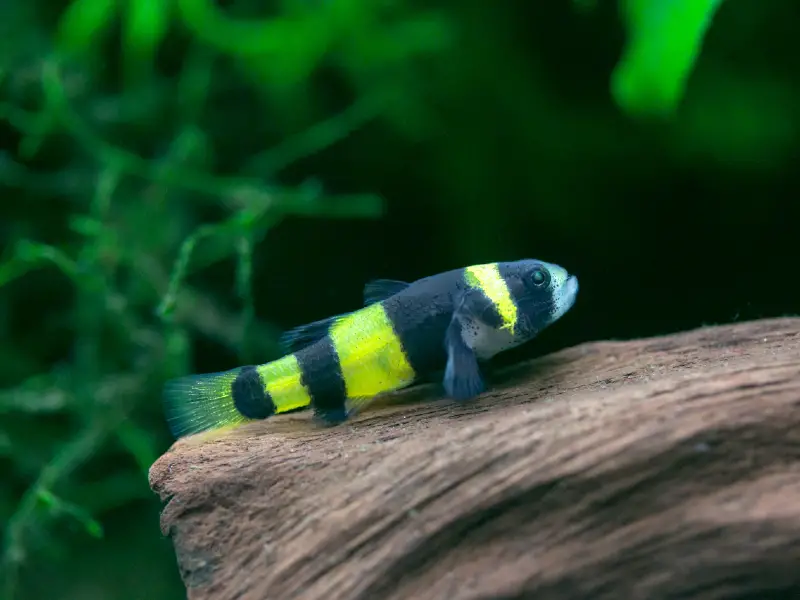
This species is native to Asia, in countries such as Indonesia, Thailand, and Vietnam. They aren’t found elsewhere in the wild, but they are sold across the world in the aquarium industry.
They primarily live in brackish water habitats, where there is a mix of freshwater and saltwater. Estuaries and mangroves are the main examples.
They stick to the shallows, away from bigger fish in the deeper waters. Here the sunlight is more intense, but there’s plenty of shelter among plants and debris to hide.
The water would be warm and slightly alkaline. Salinity can vary in a brackish habitat, but Bumblebee Gobies stick to the areas with lower salinity, near to the mouth of the river.
The ideal aquarium will replicate its natural habitat. This gives them the best chance of staying healthy. Below we describe how you can make a brackish water setup like this yourself.
Tank Conditions
As bottom-dwelling fish, choosing the right substrate is important because they spend most of their time around it, even digging from time to time.
Pick a fine-grained, sandy substrate and layer it over the base of the aquarium. This is smooth and much less likely to scratch and cause injury than coarser gravels.
What you put on top of the substrate is important too. Bumblebee Gobies enjoy having lots of hiding spots, especially when they are shy after having just been added to a new aquarium.
Use rocks and driftwood to create separate caves and crevices.
Add plenty of plant life too. Live plants are a great source of natural shelter, offering cover from stressful lights or boisterous tank mates.
The plant species you choose is up to you based on where you want it to go and how you want your tank to look. You are restricted by their tolerance for brackish water though, you could try Java Fern or Anubias Nana.
You don’t need any special equipment, just a filter, and a heater. Standard aquarium lighting is fine.
Try to avoid creating strong currents with air/water pumps. Bumblebee Gobies do not tolerate these well, preferring minor currents. The filter outlet should create enough water movement.
Set your heater in the range of 72-84°F. The pH should be between 7.0 and 8.5. Use an aquarium salt to create a salinity of 1.002-1.006.
Maintaining these water conditions is key to keeping your gobies healthy over time.
What Size Aquarium do they need?
Bumblebee Gobies are a small species, reaching just 1.5 inches when fully grown. This means you can keep a small group in aquariums as small as 10 gallons if it is set up as we describe above.
Bigger tanks are always better though. Not only are they easier to maintain, but your fish will be happier with more space to swim around in. It could even keep them healthier and help them live longer too.
How Many Can be kept per gallon?
The more fish you want to keep, the bigger your tank will need to be. You don’t want to risk overcrowding the aquarium as this can lead to many problems.
Try to provide 3-5 gallons for each additional Bumblebee Goby. Again, the more space you cn give them, the better.
Tank Mates
You might think that choosing the right tank mates is the biggest decision to make. You need to pick species you like while also ensuring that there won’t be any compatibility problems.
Bumblebee Gobies are harder to find tank mates for than most species. This is because they are from brackish water habitats, which narrows the range of possible companions.
Their temperament doesn’t cause compatibility problems. They are relatively peaceful fish that can lie alongside other species.
Aggression is only displayed between two male Bumblebee Gobies when defending territory or mates. Even then, the fighting is virtually harmless and rarely results in injury.
Their small size makes Bumblebee Gobies vulnerable. They could easily be eaten by large fish, so don’t keep them with species that could fit them in their mouths.
Guppies and Mollies are some good, peaceful options.
Many aquarists choose to keep them in a single-species tank, removing all the risk of compatibility issues. This also helps when monitoring their feeding, as they can be quite picky.
Invertebrates are good options to consider. Your fish will likely ignore them, and vice versa. Try adding shrimps (like Amano Shrimp) and snails (like Nerite Snails).
Can You Keep Bumblebee Goby Together?
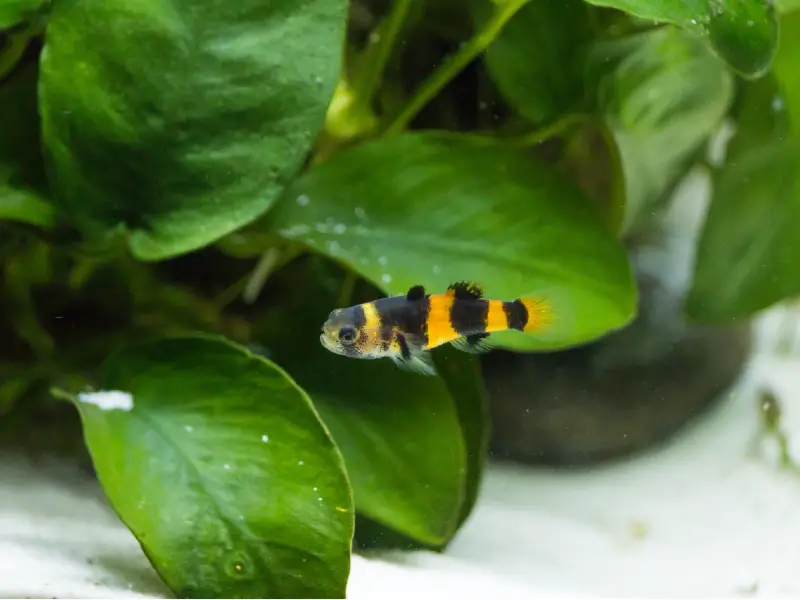
Yes, they should always be kept together. They are social fish that spend a lot of their time swimming around in a group.
Keeping a Bumblebee Goby singly would stress it out and could lead to further health problems.
Males may squabble but it’s not something to be worried about. You could keep one male per tank to mitigate this, as long as you keep some females too.
Diet
A healthy diet is essential for healthy fish. Providing a range of nutrients will help to keep your fish strong and help them to fend off diseases.
Unfortunately, feeding Bumblebee Gobies is one of the hardest parts of owning them. They are picky eaters and will only eat their favorite foods.
Dried foods are usually out of the question. Flakes and pellet will largely be ignored and left to rot on the bottom of the tank. These foods are less nutritious anyway and should never be the sole component of a fish’s diet.
Bumblebee Gobies are carnivores, requiring nutritious, protein-rich foods. They generally only eat live or frozen foods, which can be more of a hassle to buy and store. They cost more too.
There are lots of live/frozen foods to choose from though, including brine shrimp, daphnia, tubifex worms, and bloodworms.
Some fish might show individual preferences. Some might accept foods that other usually don’t, like dried foods. You might even be able to train them to accept certain foods, but don’t bank on this.
Feed them small amounts a couple of times a day, to ease the work on their digestive system. If you notice that there is food left over, you’re probably overfeeding.
Observe your gobies closely at feeding times for the first few weeks to make sure that they are accepting the foods you’re providing. Be patient, but switch things up if they are not eating.
Don’t let their tricky feeding needs put you off, Bumblebee Gobies are worth the extra effort. Once you have a diet and a routine sorted, feeding times are much easier.
Care
These fish usually live for about 3 years in captivity, but with high-quality care, you could be able to extend this.
Bumblebee Gobies need a clean environment, just like all fish do. By regularly performing tank maintenance, this shouldn’t be an issue.
The main tasks when keeping the tank clean are performing regular partial water changes and wiping away excess algae, but there are other jobs to do too, like using a gravel vacuum and checking that all of your equipment is working.
Use a water testing kit each week to check the parameters of the water in your aquarium. You will be able to spots any problems quickly and respond to them before they can affect the health of your fish.
Poor water quality allows diseases to thrive, so a clean environment is the best way to prevent outbreaks.
Bumblebee Gobies are not particularly prone to disease, but many aquarists unknowingly stress their fish with an imperfect salinity, which can promote disease.
Unfortunately, Bumblebee Gobies are commonly kept in freshwater setups, but this should never be done. The lifespan of the fish will be dramatically reduced, especially if they weren’t raised in freshwater.
One of the most common aquarium diseases is ich, a parasite that presents as white dots over the body of an infected fish. This makes it easy to spot.
If you notice an infected fish, isolate it in a quarantine tank for treatment, to reduce the chance of the disease spreading to tank mates.
You can purchase copper-based treatments from stores for the most common pathogens. Be careful if you have invertebrates, as the copper is toxic.
Breeding
Bumblebee Gobies are not the easiest fish to breed, but it is very possible in captivity if you know what you are doing.
Spawning will only occur when environmental conditions are perfect. This means keeping the tank, and the water, clean. Perhaps increase the frequency of your cleaning regime.
A nutritious diet is also crucial. This must be full of protein. To help trigger spawning, some people increase the amount of protein in their diet.
Other triggering methods include adding a small amount of fresh water to the tank or gradually raising the water temperature to 84°F over a series of days.
These fish lay eggs, possibly up to 200 eggs at once. You will notice once breeding has started because the female Bumblebee Goby will start to swell around the abdomen.
The eggs will be laid in hiding spots around the tank. Once this has happened, separate the eggs from the adults, except for the father.
The male will guard the eggs until they hatch after about a week. At this point you should remove the father, so he doesn’t eat the emerging fry.
The fry will take a further week to start swimming freely. They will still be very small, requiring tiny foods. Infusoria is the best choice, use this until they are old enough you accept a more adult diet.
You can then move them back in with the rest of you Bumblebee Gobies.
Are Bumblebee Gobies Suitable for Your Aquarium?
You should now have a good idea as to whether these fish are right for you.
There are a few challenges to overcome initially, but once your aquarium is up and running, the experience will be much easier.
Designing their tank and diet will be done before you even buy some Bumblebee Gobies. This is easy if you’ve done your research.
After that, you just have to clean the tank and test the water regularly, to help them stay healthy.
Your effort will be rewarded. These are beautiful fish that are always moving around their environment. You’ll see them interact with each other and maybe be able to get them to mate.
What do you feed your Bumblebee Gobies? Let us know in the comments below…

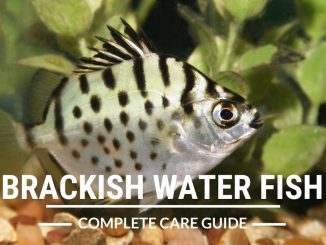
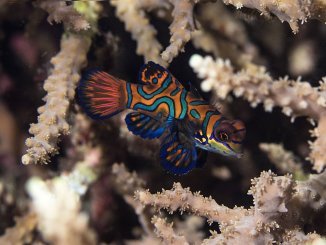
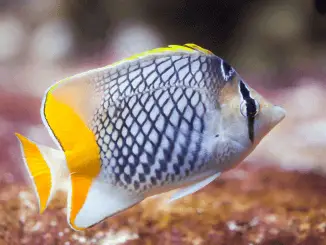
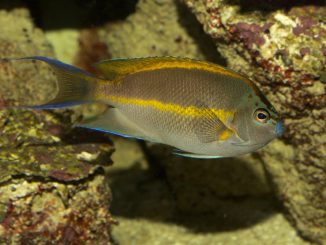
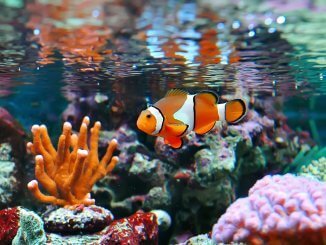
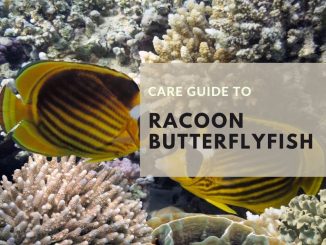
Be the first to comment